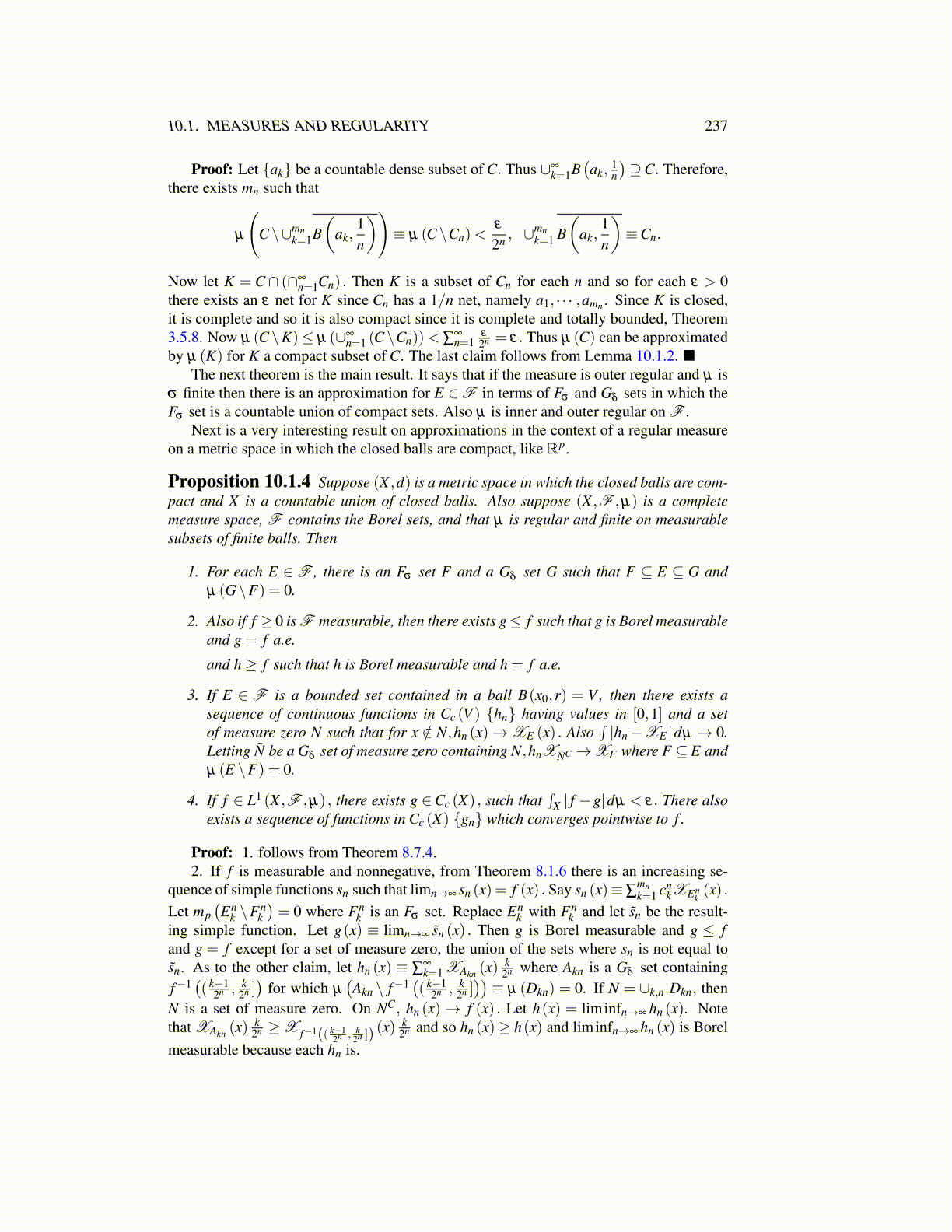
10.1. MEASURES AND REGULARITY 237
Proof: Let {ak} be a countable dense subset of C. Thus ∪∞k=1B
(ak,
1n
)⊇C. Therefore,
there exists mn such that
µ
(C \∪mn
k=1B(
ak,1n
))≡ µ (C \Cn)<
ε
2n , ∪mnk=1 B
(ak,
1n
)≡Cn.
Now let K = C∩ (∩∞n=1Cn) . Then K is a subset of Cn for each n and so for each ε > 0
there exists an ε net for K since Cn has a 1/n net, namely a1, · · · ,amn . Since K is closed,it is complete and so it is also compact since it is complete and totally bounded, Theorem3.5.8. Now µ (C \K)≤ µ (∪∞
n=1 (C \Cn))< ∑∞n=1
ε
2n = ε. Thus µ (C) can be approximatedby µ (K) for K a compact subset of C. The last claim follows from Lemma 10.1.2. ■
The next theorem is the main result. It says that if the measure is outer regular and µ isσ finite then there is an approximation for E ∈F in terms of Fσ and Gδ sets in which theFσ set is a countable union of compact sets. Also µ is inner and outer regular on F .
Next is a very interesting result on approximations in the context of a regular measureon a metric space in which the closed balls are compact, like Rp.
Proposition 10.1.4 Suppose (X ,d) is a metric space in which the closed balls are com-pact and X is a countable union of closed balls. Also suppose (X ,F ,µ) is a completemeasure space, F contains the Borel sets, and that µ is regular and finite on measurablesubsets of finite balls. Then
1. For each E ∈ F , there is an Fσ set F and a Gδ set G such that F ⊆ E ⊆ G andµ (G\F) = 0.
2. Also if f ≥ 0 is F measurable, then there exists g≤ f such that g is Borel measurableand g = f a.e.
and h≥ f such that h is Borel measurable and h = f a.e.
3. If E ∈ F is a bounded set contained in a ball B(x0,r) = V , then there exists asequence of continuous functions in Cc (V ) {hn} having values in [0,1] and a setof measure zero N such that for x /∈ N,hn (x)→XE (x) . Also
∫|hn−XE |dµ → 0.
Letting Ñ be a Gδ set of measure zero containing N,hnXÑC →XF where F ⊆ E andµ (E \F) = 0.
4. If f ∈ L1 (X ,F ,µ) , there exists g ∈Cc (X) , such that∫
X | f −g|dµ < ε. There alsoexists a sequence of functions in Cc (X) {gn} which converges pointwise to f .
Proof: 1. follows from Theorem 8.7.4.2. If f is measurable and nonnegative, from Theorem 8.1.6 there is an increasing se-
quence of simple functions sn such that limn→∞ sn (x) = f (x) . Say sn (x)≡∑mnk=1 cn
kXEnk(x) .
Let mp(En
k \Fnk
)= 0 where Fn
k is an Fσ set. Replace Enk with Fn
k and let s̃n be the result-ing simple function. Let g(x) ≡ limn→∞ s̃n (x) . Then g is Borel measurable and g ≤ fand g = f except for a set of measure zero, the union of the sets where sn is not equal tos̃n. As to the other claim, let hn (x) ≡ ∑
∞k=1 XAkn (x)
k2n where Akn is a Gδ set containing
f−1(( k−1
2n , k2n ])
for which µ(Akn \ f−1
(( k−1
2n , k2n ]))≡ µ (Dkn) = 0. If N = ∪k,n Dkn, then
N is a set of measure zero. On NC, hn (x)→ f (x) . Let h(x) = liminfn→∞ hn (x). Notethat XAkn (x)
k2n ≥X f−1(( k−1
2n , k2n ]) (x)
k2n and so hn (x)≥ h(x) and liminfn→∞ hn (x) is Borel
measurable because each hn is.